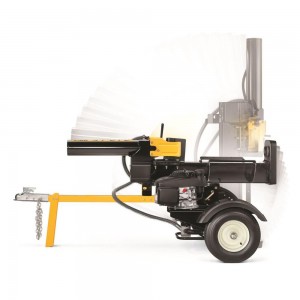Ready to put your Cub Cadet LS 25 log splitter to work? Here’s everything you need to know from switching cut positions to towing while keeping the splitter and your fingers intact.
Starting and Stopping the Engine
Check the engine owner’s manual for instructions on starting and stopping the engine: due to constant running changes, there isn’t a one-size-fits-all method for all LS 25 log splitters. The engine should be off when changing beam position or towing the splitter. Once the engine is running, let it warm up before cutting wood.
Changing Operating Positions
The cutting beam is fairly heavy, so it’s a good idea to have the splitter secured: it should always be on flat, dry, solid ground, and both wheels should be blocked both front and back. If possible, have an extra person on hand to help tilt the beam.
To move the beam into the vertical position:
1. Pull out the horizontal beam lock, located beneath the control handle.
2. Tilt the beam into the vertical position.
3. Pull out the vertical beam lock, located next to the left side of the log tray, and rotate it clockwise until it slides back into the beam.
To move the beam into the horizontal position:
1. Pull out the vertical beam lock, located next to the left side of the log tray.
2. Tilt the beam into the horizontal position. The horizontal beam lock will snap into place once the beam is in position.
The splitter should always be used in the vertical position when splitting large logs.
Using the Control Handle
The handle has three positions. When facing the handle, pushing it to the left will move the wedge forward to split wood, while pushing it right will move the wedge back to the starting position. The lever will return to the upright neutral position after being pushed left to extend the wedge, but will stay in the reverse position when moved right. It’s designed this way so that if you leave the controls for any reason, the wedge won’t go into the wood any further, preventing damage the splitter and possible injury to the operator.
Splitting Wood
This splitter is designed for the operator to be standing on the right side next to the control handle. The handle should be operated with the right hand.
1. Start the engine.
2. Place the log against the end plate. Position the log so that the wedge will strike in the direction of the grain.
3. To stabilize the wood, place your left hand on the side of the wood opposite of the beam.
4. Move the control handle to the forward position.
5. Move your left hand away once the wedge makes contact with the wood.
6. Once the wood has split, move the control handle to the reverse position.
If the wood is only partially split, move the control handle to the reverse position. This will pull the wedge and wood through the dislodger. Never remove partially split wood by hand: once the pressure from the wedge is removed, the wood can trap and crush fingers.
Towing the Splitter
1. Move the beam into the horizontal position. Make sure the horizontal lock is engaged.
2. Support the tongue. Remove the spring clip and clevis pin from the jack stand and tilt the stand up against the tongue. Reinsert the spring clip and pin.
3. Attach the hitch to a Class I or higher two-inch ball. If the hitch is loose, turn the adjustment nut, located underneath the hitch, one turn clockwise. If it won’t fit over the ball, turn the nut one turn counterclockwise. Check the fit and adjust again if needed.
4. Connect the safety chains to the vehicle.
Do not tow the splitter at speeds faster than 45 mph (70 kph.)
Where to Buy Cub Cadet Log Splitter Parts
Cubparts.com has everything you need for anything Cub Cadet from their first tractors to new small engine equipment like the LS 25 log splitter. An advanced search system and online parts diagrams makes it easy to find the correct OEM parts, and with thousands of items in stock, most orders can be shipped shortly after ordering.

